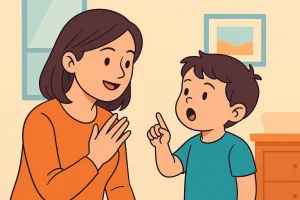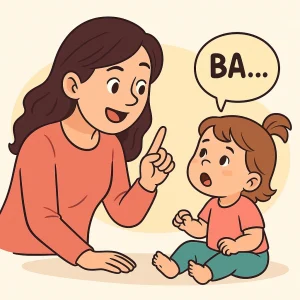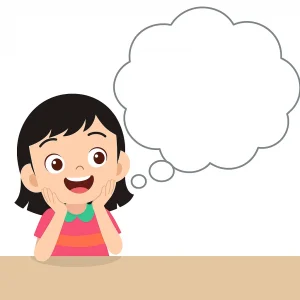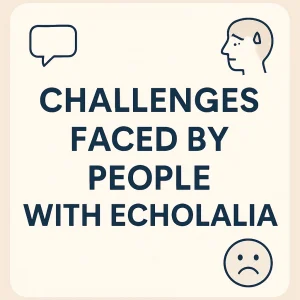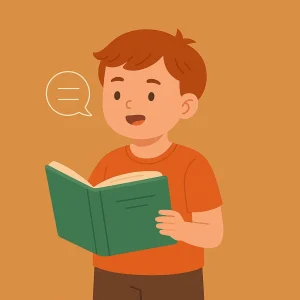How Dysarthria Affects School and Social Life
By Rajini D
Last Updated: April 28, 2025
If your child has been diagnosed with dysarthria, you may be wondering how it will affect their learning, friendships, and everyday life. You’re not alone—many parents feel overwhelmed when their child struggles to speak clearly or is misunderstood at school or in social settings. Dysarthria in children is more than just a speech issue—it can shape how they participate in class, how they connect with peers, and how confident they feel. But with the right support, children with dysarthria can thrive in both school and social life.
What Is Dysarthria in Children?
Understanding the Basics of Motor Speech Disorders
Imagine your child knows exactly what they want to say—but their mouth muscles just won’t cooperate. That’s what happens with dysarthria, a motor speech disorder that affects how clearly a child can speak. It doesn’t mean they don’t understand language. In fact, many kids with dysarthria are bright and expressive in other ways—they just struggle to get the words out clearly.
Let’s break it down so it’s easier to understand.

What Is Dysarthria?
Dysarthria is a speech disorder caused by weak or uncoordinated muscles used for talking. These include the lips, tongue, vocal cords, and even the diaphragm (used for breathing while speaking). Because these muscles don’t work properly, a child’s speech may sound:
- Slurred or mumbled
- Very slow or very fast
- Too soft or too loud
- Monotone (without expression)
Definition Table:
| Term | Meaning |
|---|---|
| Dysarthria | A motor speech disorder caused by weak muscle control |
| Motor Speech | How the brain coordinates muscles to produce clear, spoken words |
| Speech Clarity | How easily others can understand a child’s spoken words |
How Is Dysarthria Different From Other Speech Disorders?
This is a common question from parents:
“Is dysarthria the same as stuttering or speech delay?”
Not quite. Here’s how they differ:
| Disorder | Root Cause | Key Characteristics |
|---|---|---|
| Dysarthria | Muscle weakness or brain injury | Slurred, slow, unclear speech |
| Apraxia of Speech | Brain struggles to plan speech movements | Speech may be inconsistent, groping for words |
| Speech Delay | Developmental or environmental factors | Behind in speech milestones |
| Stuttering | Disrupted flow of speech | Repetitions, prolongations, or blocks |
What Causes Dysarthria in Children?
Dysarthria is usually linked to neurological or developmental conditions. Some children are born with it, while others may develop it after an illness or injury.
Common causes include:
- Cerebral palsy
- Traumatic brain injury
- Muscular dystrophy
- Stroke (in rare pediatric cases)
- Neuromuscular diseases
- Brain tumors or infections
How Dysarthria Affects School Life
When a child has dysarthria, school life can feel like a daily obstacle course. Even if they’re eager to participate and learn, their speech muscles may not keep up with their thoughts, making classroom communication harder than it should be. This doesn’t mean they aren’t capable—it just means they need a different kind of support.
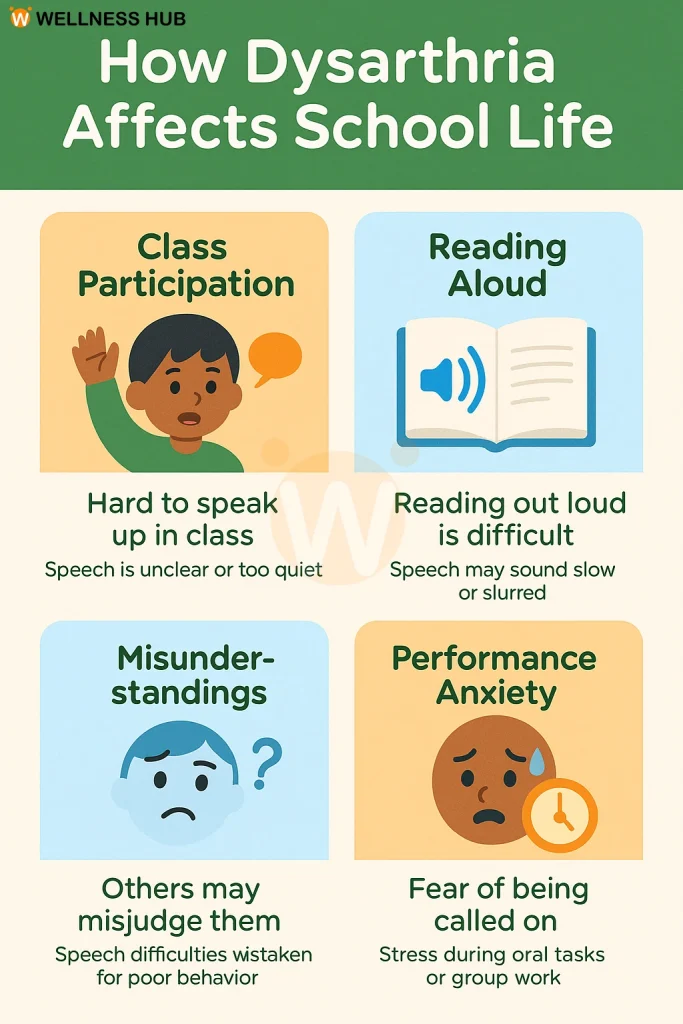
Let’s look at how speech disorders in school-aged children, especially dysarthria, show up in the classroom.
1. Struggles With Verbal Participation in Class
In many classrooms, kids are encouraged to answer questions, join discussions, and share ideas out loud. For a child with dysarthria, this can be tough.
They might:
- Speak too softly or unclearly to be understood
- Feel frustrated when others ask them to repeat themselves
- Stay quiet to avoid embarrassment
Why it matters: Participation builds confidence. When a child avoids speaking up, they miss chances to shine academically and socially.
2. Difficulty With Reading Aloud and Presentations
Many school activities—like reading a paragraph out loud or giving a short presentation—rely heavily on clear speech. For a child with dysarthria, this can feel overwhelming.
Common challenges include:
- Slurred words that classmates don’t understand
- Trouble controlling voice volume
- Embarrassment that leads to reluctance
These tasks can quickly turn into sources of anxiety rather than learning opportunities.
3. Challenges in Written Expression (Due to Motor Issues)
Dysarthria doesn’t just affect speech—it can also involve fine motor difficulties, which makes writing and typing harder too.
You might notice:
- Illegible handwriting or slow writing speed
- Fatigue during long writing tasks
- Trouble organizing written thoughts due to frustration with the process
Tip: Speech-language therapists and occupational therapists can work together to support both communication and motor skills.
4. Misunderstanding From Teachers or Peers
Kids with dysarthria may be wrongly perceived as:
- Not paying attention
- Uninterested
- “Lazy” with speech
- Academically behind
This often happens simply because their speech isn’t easy to understand. But remember—speech clarity does not reflect intelligence.
Helping educators and classmates understand dysarthria can prevent misjudgment and promote empathy.
5. Academic Performance Anxiety
When speaking or writing is difficult, school can become stressful. Children with dysarthria may:
- Worry about being called on in class
- Avoid group activities
- Freeze during oral exams or viva-style assessments
Over time, this can impact self-esteem and lead to school refusal, especially if their challenges go unsupported.
What Parents Can Do
- Communicate openly with your child’s teachers about their speech needs
- Ask for classroom accommodations (e.g., extra time, alternative ways to present work)
- Work with specialists like a speech therapist to build confidence and coping strategies
How Dysarthria Affects a Child’s Social Life
We all want our children to feel connected, confident, and included. But for kids with dysarthria, social interaction can be one of the hardest parts of growing up—not because they don’t want to connect, but because their speech clarity makes it harder for others to understand them.
Here’s how this speech disorder can affect a child’s social life—and what you can do to support them.
6. Trouble Making Friends Due to Unclear Speech
Friendships often begin with simple conversations: “Wanna play?” “What’s your name?” “Can I join?” But when a child’s speech is slurred or hard to follow, other kids may not know how to respond.
Common signs:
- Struggles during introductions
- Friends often asking, “What did you say?”
- Hesitation to speak up in group settings
Why it matters: Kids with dysarthria can become observers instead of participants, not because they don’t want friends—but because they’re worried about being misunderstood.
7. Frustration From Not Being Understood
Imagine saying something perfectly in your mind—but no one gets it. That’s a daily reality for many children with dysarthria.
They may:
- Repeat themselves several times
- Get upset when adults or peers ask them to “speak clearly”
- Give up on conversations altogether
This communication breakdown can be frustrating and emotionally draining, even when their intentions are clear.
8. Avoidance of Group Activities or Games
In social games and group play, speech plays a huge role—giving instructions, reacting quickly, sharing ideas.
For kids with dysarthria, this means:
- Struggling to keep up in fast-paced play
- Avoiding group games like board games, role-playing, or team sports
- Preferring solo play (which can be misread as antisocial behavior)
Note: This avoidance often comes from a place of self-protection, not lack of interest.
9. Emotional Impact: Low Self-Esteem or Isolation
Over time, repeated struggles with speech can take a toll on your child’s emotional well-being.
Emotional signs to watch for:
- Saying “I’m stupid” or “No one likes me”
- Refusing to attend parties or group events
- Crying or withdrawing after social situations
These aren’t just mood swings—they’re real signs of social fatigue and growing self-doubt.
10. Risk of Bullying or Teasing
Sadly, children with visible or audible differences are at higher risk of bullying. Slurred or slow speech may draw unwanted attention or mockery, especially from peers who don’t understand the condition.
Potential red flags:
- Sudden fear of going to school
- Asking to change friend groups
- Mimicked speech from other kids
Educating classmates and teachers about dysarthria and social interaction challenges can reduce stigma and create a more inclusive space.
How You Can Help as a Parent
Support from family and school makes a world of difference.
Try This:
- Practice social scripts at home (e.g., how to introduce themselves)
- Arrange playdates with understanding peers
- Talk to teachers about seating arrangements and buddy systems
- Celebrate small social wins to boost confidence
What Can Parents Do?
When your child has dysarthria, you’re not just navigating speech challenges—you’re managing school pressures, social hurdles, and emotional ups and downs. But here’s the good news: you play a powerful role in helping your child grow, communicate, and thrive.
Here are two of the most effective, real-world strategies to support your child both in and out of school.
11. Work With a Speech-Language Pathologist
Partnering with a speech-language pathologist (SLP) is one of the best ways to support children with dysarthria. These professionals are trained to understand how speech muscles work—and more importantly, how to help your child use them more effectively.
An SLP can help your child:
- Improve speech clarity and control
- Strengthen weak mouth and tongue muscles
- Learn breathing techniques for better sentence flow
- Build confidence through guided conversation
Most importantly, they work with you as a parent. They’ll give you strategies you can use at home and advocate for the right accommodations in school.
12. Build Confidence Through Daily Practice at Home
Speech therapy isn’t limited to the clinic or video calls. In fact, your home is the best classroom for reinforcing what your child learns.
Here are easy ways to build speech confidence at home:
Use visuals, gestures, or AAC (Augmentative and Alternative Communication)
- Use flashcards, picture boards, or pointing
- Encourage gestures and body language
- Consider AAC tools if recommended by your therapist
Encourage play-based communication
- Talk during playtime—dolls, building blocks, pretend cooking
- Take turns and model short phrases
- Use their interests (cars, animals, etc.) to spark conversation
Practice speech clarity without pressure
- Repeat back what they said clearly, so they hear the correct version
- Avoid saying “say it again” too often—it can feel frustrating
- Celebrate effort, not just “perfect” speech
Helpful At-Home Practice Chart:
| Activity | Goal | How Often? |
|---|---|---|
| Naming toys during play | Word retrieval, clarity | Daily (5–10 mins) |
| Reading picture books | Listening + expressive speech | 3–4 times/week |
| Family mealtime chats | Functional, real-life speech use | Daily |
| Mirror exercises | Mouth movement awareness | 2–3 times/week |
How Wellness Hub Supports Children With Dysarthria
When you’re looking for the right help for your child’s speech challenges, the search can feel overwhelming—especially if you live abroad or in an area with limited local resources. That’s exactly where Wellness Hub steps in.
We specialize in making expert speech therapy accessible, effective, and family-friendly, no matter where you live.
Expert-Led Online Speech Therapy for Dysarthria
Your child deserves care from someone who understands the unique challenges of motor speech disorders like dysarthria. At Wellness Hub, every session is led by a qualified, experienced speech-language pathologist (SLP) trained to:
- Improve muscle coordination for clearer speech
- Support breathing, pacing, and pronunciation
- Personalize goals based on your child’s needs and comfort level
All sessions are 1-on-1 and online, so your child can learn in the comfort of your home.
Easy Access for Families in India and Abroad
Whether you’re in India or living overseas as an NRI, our platform is built for you. We’ve helped families in:
- The United States
- UAE and Middle East
- United Kingdom
- Australia
- And across smaller towns in India with limited therapy options
No long commutes, no waitlists. Just accessible, high-quality care—when and where you need it.
Personalized, Home-Based Therapy Plans
Every child is different. That’s why we create customized therapy plans based on:
- Your child’s age and speech level
- The severity of dysarthria
- Your daily routine and availability
- Tools your child responds best to (visuals, games, AAC, etc.)
Sample Custom Plan Preview:
| Week | Focus Area | Practice Tools |
|---|---|---|
| 1 | Lip & jaw control | Mirror exercises, straws |
| 2 | Speech clarity in short words | Flashcards, rhyming songs |
| 3 | Sentence flow & expression | Picture stories, roleplay |
| 4 | Social conversation practice | Turn-taking games |
And yes—parents are part of the journey too.
Parent Coaching to Reinforce Therapy Goals
Your involvement is key. Our therapists guide you step-by-step on:
- How to support speech goals at home
- What to model during daily routines
- How to respond when your child struggles
- Ways to celebrate progress (big and small)
Conclusion
Dysarthria doesn’t define your child. With the right support, they can grow, learn, and make friends like any other kid. As a parent, you’re already doing something amazing by looking for help. You’re not alone in this. At Wellness Hub, we offer expert-led online speech therapy for kids in India and worldwide. Our team helps children speak more clearly and feel confident—step by step. Every small effort matters. Keep believing in your child. And if you ever need guidance, we’re just one call away.
Frequently Asked Questions:
1. What is dysarthria in children?
Dysarthria is a motor speech disorder where a child has difficulty controlling the muscles used for speaking. This can lead to slurred, slow, or unclear speech. It’s often caused by neurological conditions like cerebral palsy or brain injuries.
2. How does dysarthria affect my child’s learning?
Children with dysarthria may struggle with verbal participation in class, reading aloud, or giving presentations. These challenges can impact their confidence and academic performance.
3. Can dysarthria impact my child’s social life?
Yes. Speech clarity issues can make it hard for children to make friends or participate in group activities, leading to feelings of isolation or frustration.
4. Is there a cure for dysarthria?
While there’s no cure, speech therapy can significantly improve communication skills. Early intervention and consistent practice can lead to noticeable progress.Parents+1KidsHealth+1
5. How can I support my child at home?
- Practice speech exercises recommended by a speech-language pathologist.
- Use visual aids and gestures to support communication.
- Encourage play-based activities that promote speaking.
- Be patient and celebrate small achievements.
6. What is the role of a speech-language pathologist (SLP)?
An SLP assesses and treats speech disorders. They create personalized therapy plans to help your child improve speech clarity and communication skills.
7. Can my child receive speech therapy online?
Yes. Online speech therapy offers flexibility and can be just as effective as in-person sessions. Platforms like Wellness Hub provide expert-led online therapy tailored for children.
8. How long does speech therapy take to show results?
Progress varies for each child. Some may see improvements in a few months, while others might need longer. Consistency and parental involvement play crucial roles in the therapy’s effectiveness.
9. Is dysarthria common in children?
While not as common as other speech disorders, dysarthria does occur in children, especially those with neurological conditions. Early diagnosis and intervention are key to better outcomes.
10. Where can I find resources to help my child?
There are many resources available:
- Consult with your child’s pediatrician for referrals.
- Explore online platforms like Wellness Hub for therapy options.
- Join support groups for parents of children with speech disorders.
About the Author:
Rajini Darugupally
M.Sc., Speech-Language Pathologist (9+ years of experience)
Rajini is a passionate and dedicated Speech-Language Pathologist with over 9+ years of experience, specializing in both developmental speech and language disorders in children and rehabilitation in adults. Driven by a desire to empower each individual to find their voice, Rajini brings a wealth of experience and a warm, genuine approach to therapy. Currently, at Wellness Hub, she thrives in a team environment that values innovation, compassion, and achieving results for their clients.
Book your Free Consultation Today
Parent/Caregiver Info:
Client’s Details:
* Error Message


